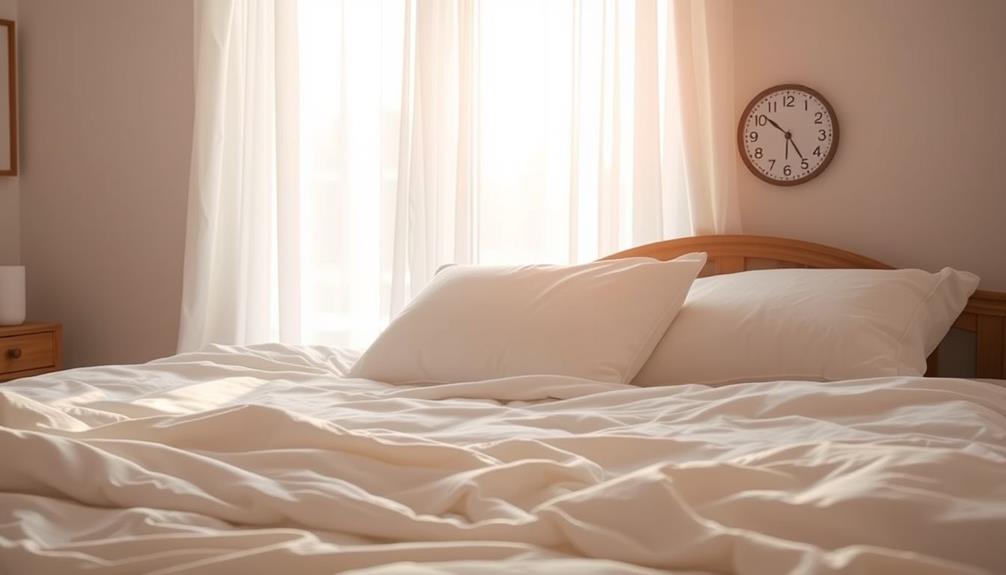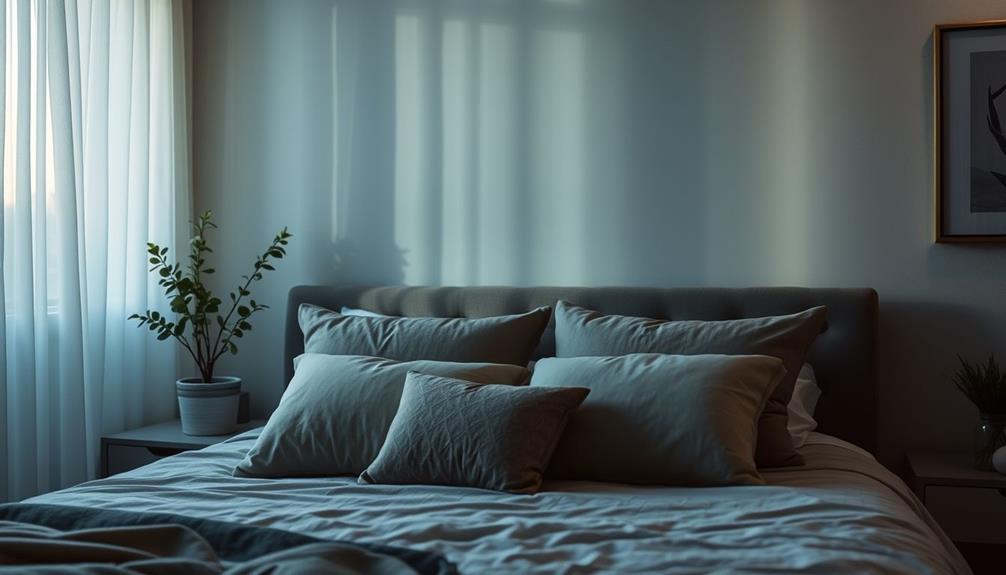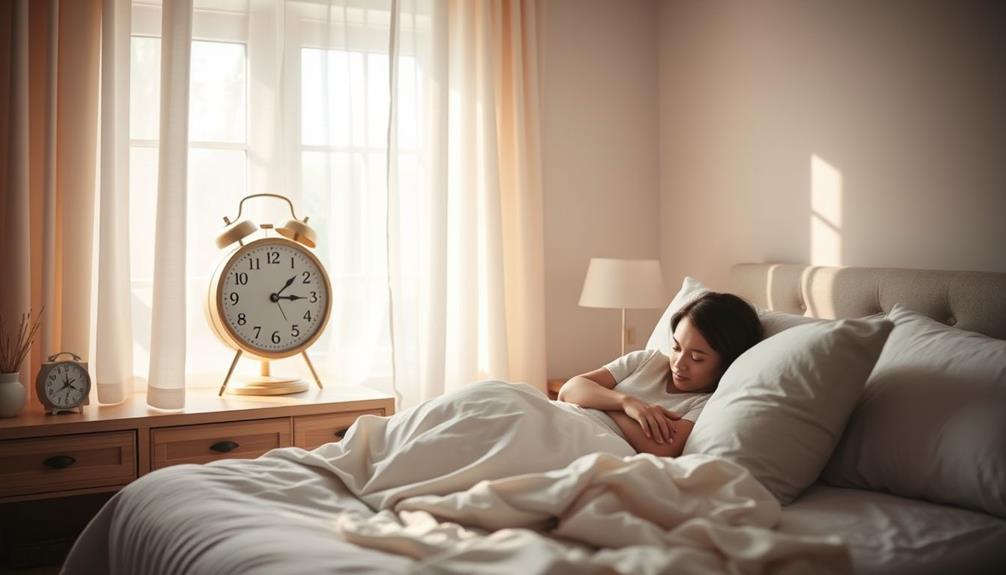Power naps, ideally lasting 20 minutes, can recharge your energy and enhance your cognitive abilities. Napping during the 1 PM to 3 PM window aligns with natural energy dips, optimizing your alertness. These short naps help consolidate memories and improve focus, boosting productivity by around 34%. To maximize their benefits, create a calming environment—dim the lights, minimize noise, and set an alarm to avoid oversleeping. Plus, you can combine a quick nap with coffee for an even greater energy lift. If you're curious about the best napping techniques and their science, there's plenty more to explore.
Key Takeaways
- A 20-minute power nap enhances cognitive performance by approximately 34%, improving alertness and memory consolidation.
- The optimal napping window is between 1 PM and 3 PM, aligning with natural energy dips.
- Short naps of 15-20 minutes can boost productivity and reduce stress by lowering cortisol levels.
- Creating a comfortable, dark, and quiet environment improves nap quality and facilitates relaxation.
- Power naps are more effective than caffeine for enhancing alertness and do not disrupt nighttime sleep quality.
Understanding Power Naps
Power naps can be a game-changer for your productivity. They're short naps, lasting between 10 to 30 minutes, designed to help you enhance alertness without the grogginess that comes from deeper sleep stages. By engaging primarily in NREM stages 1 and 2, power naps allow you to wake up refreshed and ready to tackle your tasks.
Incorporating effective strategies for maintaining energy levels, such as hydration tips essential for high-altitude trekking, can further enhance your focus throughout the day.
Research shows that a 20-minute power nap can improve cognitive performance by as much as 34%. That's significant! These quick naps are perfect for boosting memory and sharpening your decision-making abilities. When you take a successful power nap, you're also aiding your brain in eliminating toxins and consolidating memories.
Timing is vital, too. Ideally, you should nap between 1 PM and 3 PM, aligning with your natural circadian rhythm. This is when energy dips typically occur, making it the perfect window to recharge.
Ideal Timing for Napping

Napping at the right time can greatly boost your productivity and alertness. The perfect timing for an afternoon nap is between 1 PM and 3 PM, as this aligns with your natural circadian rhythms and those common post-lunch energy dips. By taking a nap during this window, you can enhance cognitive function and creativity without disrupting nighttime sleep.
Here's a quick look at ideal napping times:
| Time Frame | Benefits |
|---|---|
| 1 PM – 3 PM | Aligns with circadian rhythms |
| 15-20 minutes | Enhances alertness and mood |
| Later than 3 PM | Can disrupt nighttime sleep |
| Consistent timing | Improves overall results |
It's essential to keep your nap short—15 to 20 minutes is perfect to avoid sleep inertia. Remember that napping later in the afternoon can negatively impact your ability to fall asleep at night. Consistency is key; if you stick to a regular napping schedule, your body will adapt, making your afternoon naps even more effective. So, find your sweet spot and enjoy the benefits!
Benefits of Short Naps

A quick 15-20 minute nap can work wonders for your productivity and mental clarity. Dogs, much like humans, also benefit from rest, as regular naps can contribute to their overall health and well-being understanding safe foods is essential for canine health.
Here are three key benefits of incorporating short naps into your routine:
- Boost Alertness: Studies show that a brief nap can enhance cognitive performance, leading to a productivity increase of approximately 34%. You'll feel more awake and focused after just a short rest.
- Improve Memory: Napping helps solidify new information and enhances your learning capabilities. This means those concepts you're trying to grasp will stick better, making study sessions more effective.
- Reduce Stress: Power naps can lower cortisol levels, promoting relaxation and well-being. This reduction in stress not only improves your mood but also supports long-term health.
Incorporating short naps into your day isn't just about catching up on sleep; it's about maximizing your mental and physical performance.
You'll notice improved reaction times and overall health benefits too, especially if you're feeling the effects of sleep deprivation.
Creating a Napping Environment

Transform your space into a restful retreat by creating an ideal environment for short naps. A proper napping environment is key to maximizing your recharge time. Aim for a dark, cool room, ideally between 60-67°F. To block out light, consider using eye masks or blackout curtains. For a quieter experience, earplugs or white noise machines can effectively mask disruptive sounds.
Here's a quick reference for setting up your napping area:
| Element | Suggestions | Benefits |
|---|---|---|
| Light Control | Eye masks, blackout curtains | Promotes quicker sleep onset |
| Sound Management | Earplugs, white noise machines | Minimizes distractions |
| Comfort | Soft bedding, elevate legs with a pillow | Enhances relaxation |
| Technology Silence | Silence electronic devices | Reduces interruptions |
| Space Design | Cozy corner or nap room | Signals it's time to rest |
Before you nap, practice deep breathing to help your mind and body shift into a restful state. By thoughtfully crafting your napping environment, you'll maximize the benefits of your power naps and wake up feeling refreshed.
Napping Techniques and Tips

To make the most of your power naps, focus on timing, duration, and relaxation techniques.
Incorporating gentle breathing exercises can help alleviate tension and enhance relaxation, similar to techniques used in yoga for back pain.
Aim for a consistent napping schedule between 1 PM and 3 PM, and keep your naps around 15-20 minutes for ideal alertness.
Before you close your eyes, try some deep breathing or meditation to help you drift off quickly and enhance the benefits of your nap.
Ideal Napping Environment
Creating the perfect napping environment is essential for maximizing the benefits of your short rest. To set yourself up for success, consider these three key factors:
- Darkness: Block out light using eye masks or blackout curtains to promote quicker sleep onset. Engaging in exploratory play before your nap can help calm your mind, making it easier to drift into a restful state.
- Temperature: Keep the room cool, ideally between 60-67°F, to enhance rest quality.
- Noise Control: Use white noise machines or earplugs to minimize distractions.
By focusing on these elements, you'll create an ideal napping environment that supports good sleep hygiene.
Before you nap, engage in relaxation techniques like deep breathing or progressive muscle relaxation to calm your mind and body.
Remember to elevate your legs with a pillow for added comfort and improved circulation. Setting an alarm for 15-20 minutes is vital to prevent oversleeping and experiencing sleep inertia, ensuring you wake up refreshed.
With these tips, you can transform your napping experience, allowing those brief moments of rest to recharge your energy effectively.
Duration and Timing
Now that you've set up an ideal napping environment, understanding the right duration and timing for your power nap can greatly enhance its benefits. Aim for a duration of 15 to 20 minutes. This timeframe allows you to experience lighter stages of sleep without dipping into deep sleep, which can leave you groggy and disoriented due to sleep inertia.
Notably, just as cats may seek comfort in familiar scents when their owners are absent, creating a calming atmosphere for your nap can help enhance relaxation and ease the shift into sleep cats seek comfort.
Timing is equally important. The best window for your power nap is between 1 PM and 3 PM, aligning with your body clock and the natural dip in energy that follows lunch. Taking your nap during this period can help you recharge effectively.
To avoid oversleeping, it's vital to set an alarm. Even a short nap exceeding 30 minutes might disrupt your alertness and lead to that dreaded sleep inertia.
Consistency is key; napping at the same time each day helps reinforce your body clock, making it easier to drift off and wake up refreshed. By focusing on the right duration and timing, you can maximize the benefits of your power nap and enhance your overall productivity.
Relaxation Techniques Before Napping
Developing a pre-nap relaxation routine can greatly enhance your ability to fall asleep quickly and enjoy a revitalizing power nap. Incorporating elements of self-love quotations can remind you to prioritize your well-being and embrace the importance of rest.
Here are three effective techniques to incorporate:
- Deep Breathing Exercises: Focus on your breath. Inhale deeply for a count of four, hold for four, and exhale for four. This simple exercise calms your mind and body, making it easier to drift off.
- Progressive Muscle Relaxation: Tense and then release each muscle group, starting from your toes and working your way up. This technique reduces physical tension and prepares your body for rest.
- Calming Music: Create a soothing atmosphere by listening to calming music or nature sounds. This can enhance relaxation and help you shift into sleep more quickly.
Additionally, establish a consistent pre-nap routine by dimming the lights and reducing noise. It signals to your body that it's time to relax.
Don't forget to avoid screens and bright lights at least 30 minutes before your nap, as they can interfere with your ability to unwind and fall asleep.
Embrace these techniques, and watch your power naps become more effective!
Power Naps Vs. Caffeine

When you're caught in the battle between power naps and caffeine, understanding their differing impacts on alertness and cognitive function can help you make the best choice for your needs.
Research shows that a power nap lasting 15-20 minutes can enhance alertness and cognitive function more effectively than caffeine, which often delivers only a temporary energy boost. Incorporating healthy habits for blood pressure control can also be beneficial, as stress management techniques play a vital role in overall wellness.
While caffeine might perk you up quickly, it can actually impair memory performance and disrupt your sleep later on. In contrast, a short nap rejuvenates energy levels without impacting nighttime sleep quality, making it a healthier option.
If you're looking for a way to maximize alertness, consider combining a power nap with coffee consumed just before your nap. This strategy leverages caffeine's effects against adenosine, ensuring you wake up feeling even more alert.
Plus, studies indicate that a brief nap can improve physical performance and reaction times, often outperforming what caffeine can offer. Ultimately, if you want to enhance memory retention and cognitive processing, a power nap is your best bet over caffeine.
Enhancing Memory and Learning

When you take a power nap, you're not just resting; you're actually boosting your memory and learning capabilities. Short naps can help consolidate the information you've recently absorbed, making it easier for you to recall later.
Research shows that naps can improve cognitive function and enhance team dynamics in workplaces, leading to better collaboration and creativity enhance team dynamics.
Plus, a quick snooze can enhance your cognitive performance, allowing you to tackle tasks with improved clarity and creativity.
Memory Consolidation Benefits
Power naps can markedly boost your memory consolidation, making it easier for your brain to process and retain new information. This enhancement is particularly valuable in settings that require quick learning and adaptation, such as in AI transformations in healthcare.
Here's how a quick nap can elevate your learning capabilities:
- Enhanced Recall: Studies show that a brief nap can improve your ability to recall information learned prior to napping.
- NREM Stage 2 Sleep: During power naps, you enter NREM stage 2 sleep, where sleep spindles help solidify memories.
- Cognitive Performance: Research indicates that even a 20-minute nap can enhance cognitive performance by approximately 34%.
Cognitive Performance Boost
Harnessing the power of a quick nap can greatly enhance your cognitive performance, sharpening your focus and boosting your memory retention. Studies show that a 20-minute power nap can help improve your performance by up to 34% in tasks that require alertness and concentration. This short period of rest allows your brain to consolidate new information, helping you retain what you've learned while also flushing out toxins that can impede cognitive function.
Additionally, engaging in curious behaviors, such as reflecting on past experiences, can further enhance your cognitive abilities and decision-making skills, leading to a more productive day the benefits of curiosity.
Moreover, napping during the NREM stage 2 sleep, which is typically reached in these brief intervals, triggers sleep spindles. These are essential for enhancing your ability to remember and process new knowledge. Regularly incorporating power naps into your routine can also notably reduce the effects of sleep deprivation, helping you maintain ideal cognitive performance throughout the day.
Additionally, a power nap can help boost your energy, creativity, and problem-solving skills, giving you a fresh perspective on the tasks at hand. So, the next time you feel your focus wane, remember that a quick nap could be just what you need for a cognitive performance boost.
Learning Retention Enhancement
Taking a power nap not only boosts your cognitive performance but also plays an essential role in enhancing memory retention and learning.
Research shows that a brief nap can improve recall performance by 20-30%. Here are three key benefits of power napping for your memory:
- Consolidation of Information: Napping helps your brain strengthen neural connections, allowing you to better retain what you've learned.
- Enhanced Recall: Studies reveal that participants who took a 10-20 minute nap after learning performed 34% better in memory recall tests than those who stayed awake.
- Stimulated Brain Activity: Brief naps can trigger sleep spindles, vital for processing memories and boosting cognitive function.
Health Benefits of Napping

Napping offers a revitalizing burst of energy that can greatly enhance your well-being. Just a 20-minute power nap can markedly boost your alertness and cognitive function, improving your performance by about 34%. This quick recharge not only helps you feel more awake but also sharpens your memory retention and learning capabilities.
When you nap, your brain consolidates memories and clears out toxins, which is essential for peak function.
Moreover, regular napping can lower stress levels and improve your mood. Studies show that napping reduces cortisol, the hormone linked to stress and anxiety, allowing you to approach your day with a calmer mindset.
You'll even find that napping enhances your creativity and problem-solving skills, making it a valuable tool for tackling challenges.
The long-term health benefits of consistent napping are impressive too. It's associated with a lower risk of cardiovascular diseases, promoting overall health in both the short and long term.
By integrating power naps into your routine, you're not just boosting your alertness; you're also investing in your mental and physical health.
Evaluating Your Need for Naps

If you're often feeling fatigued during the day, it's essential to evaluate your sleep quality and habits.
Regular naps might signal that your nighttime rest isn't cutting it, so you may want to rethink your sleep hygiene.
Consider exploring alternatives like walking or meditation to recharge without relying solely on naps.
Signs of Fatigue
Throughout the day, recognizing the signs of fatigue can be essential for maintaining your productivity and overall well-being. Here are three key indicators that you might need a power nap:
- Difficulty Concentrating: Struggling to focus on tasks can signify that your brain needs a break.
- Increased Irritability: If you find yourself snapping at coworkers or feeling unusually moody, it could be a sign of fatigue.
- Decline in Task Performance: Noticing that you're making more mistakes or taking longer to complete tasks can indicate that your energy levels are dropping.
If you experience these signs, it's important to evaluate your sleep routine. Frequent daytime fatigue, even after a full night's sleep, suggests you might benefit from short naps. A quick 15-20 minute nap helps boost alertness and energy levels, especially for those with irregular schedules or shift work.
However, if you suffer from insomnia, be cautious with daytime naps, as they can disrupt nighttime sleep patterns.
Sleep Quality Assessment
Recognizing signs of fatigue is just the beginning; understanding the quality of your sleep is key for determining whether power naps could enhance your daily energy levels. A sleep quality assessment can help you identify any underlying sleep issues that might be causing frequent daytime fatigue.
If you're struggling with chronic fatigue, it's crucial to reflect on how well you're sleeping at night. While naps help provide short-term relief, they can't replace the need for restorative sleep cycles that your body craves.
Pay attention to how your body feels throughout the day. If you notice that your body temperature drops and fatigue sets in, it might be time to evaluate your sleep quality.
However, if you suffer from insomnia, it's best to avoid napping, as it may disrupt your nighttime sleep patterns and make things worse. A professional evaluation can pinpoint potential sleep disorders and guide you in developing effective management strategies.
Meanwhile, alternatives like walking or meditation can serve as restful breaks, allowing you to assess whether napping truly benefits your overall energy levels.
Alternatives to Napping
When you're feeling drained, it's easy to think a quick nap is the answer, but exploring alternatives might be more beneficial in the long run. Consider these options:
- Walk it out: A brisk walk can boost your energy and improve your mood, helping you feel refreshed without the grogginess that often follows napping.
- Meditate: Taking just a few minutes to meditate can reduce stress and clear your mind, providing a restful break that enhances focus.
- Evaluate sleep hygiene: Regularly reviewing your sleep environment and habits can help you identify underlying issues that may be causing daytime fatigue.
If you're frequently tired, it might signal deeper sleep issues, suggesting a need for professional evaluation rather than relying solely on napping.
Remember, while napping offers short-term relief, it doesn't replace the necessity of quality nighttime sleep. For those with insomnia, daytime naps can worsen nighttime disruptions.
Myths About Power Napping

Many people hold misconceptions about power napping that can prevent them from reaping its benefits. For instance, many think that taking a power nap is a sign of laziness, but research shows that short naps can greatly enhance your productivity and alertness.
Another common myth is that longer naps are better; however, if you nap for more than 20 minutes, you may experience grogginess instead of rejuvenation.
Some believe that power naps can replace a full night's sleep, but while they offer short-term relief, they can't substitute for the restorative benefits of adequate nighttime sleep.
Additionally, it's often assumed that napping is only beneficial for certain age groups, when in fact, power naps support cognitive function and mood for individuals of all ages.
Lastly, many worry that napping disrupts nighttime sleep. When timed correctly, especially between 1 PM and 3 PM, power naps can actually complement your sleep schedule without interfering with your nightly rest.
Conclusion
So, you thought napping was just for toddlers and lazy weekends, huh? Well, it turns out that a quick power nap can be your secret weapon for productivity and health. By embracing those 20 minutes of shut-eye, you'll boost your energy, enhance your memory, and even improve your mood—who knew resting could be so powerful? Next time you feel guilty about napping, remember: it's not just a break; it's a smart strategy for success!









